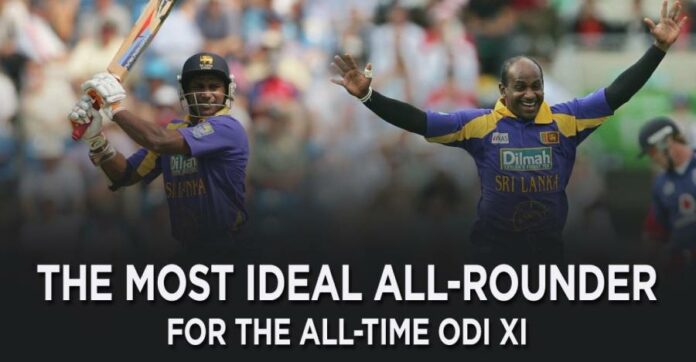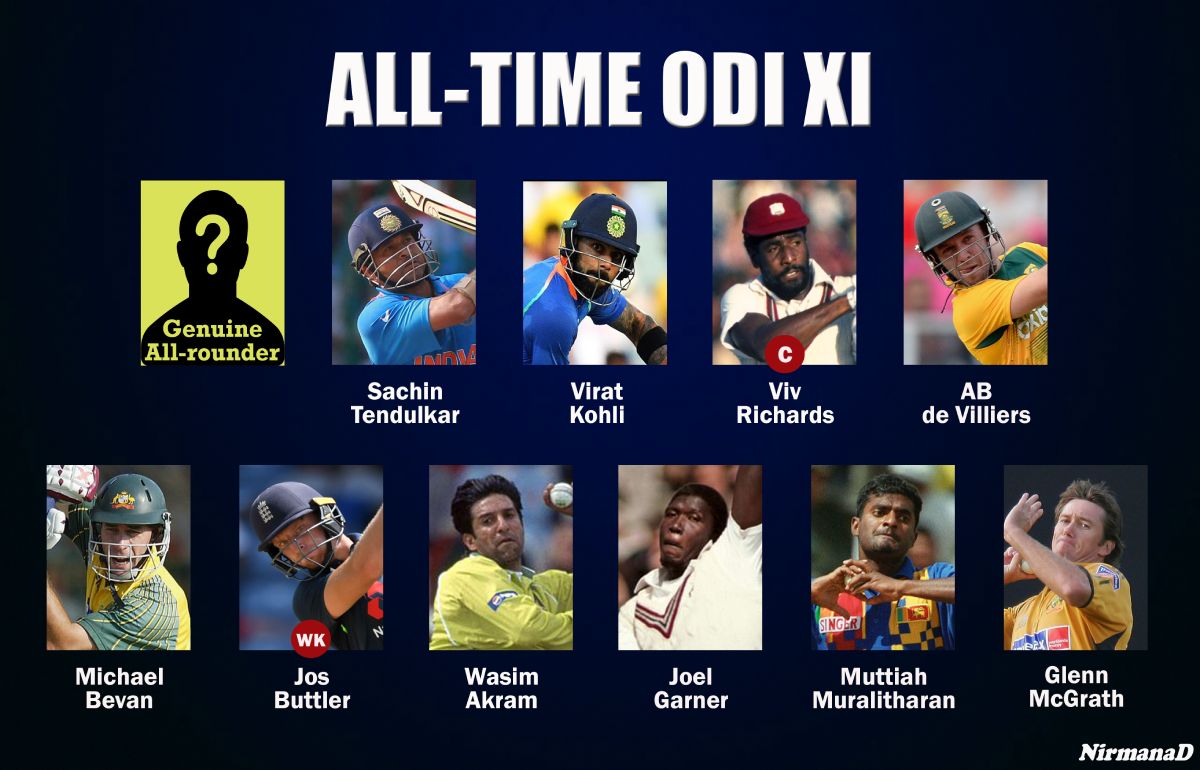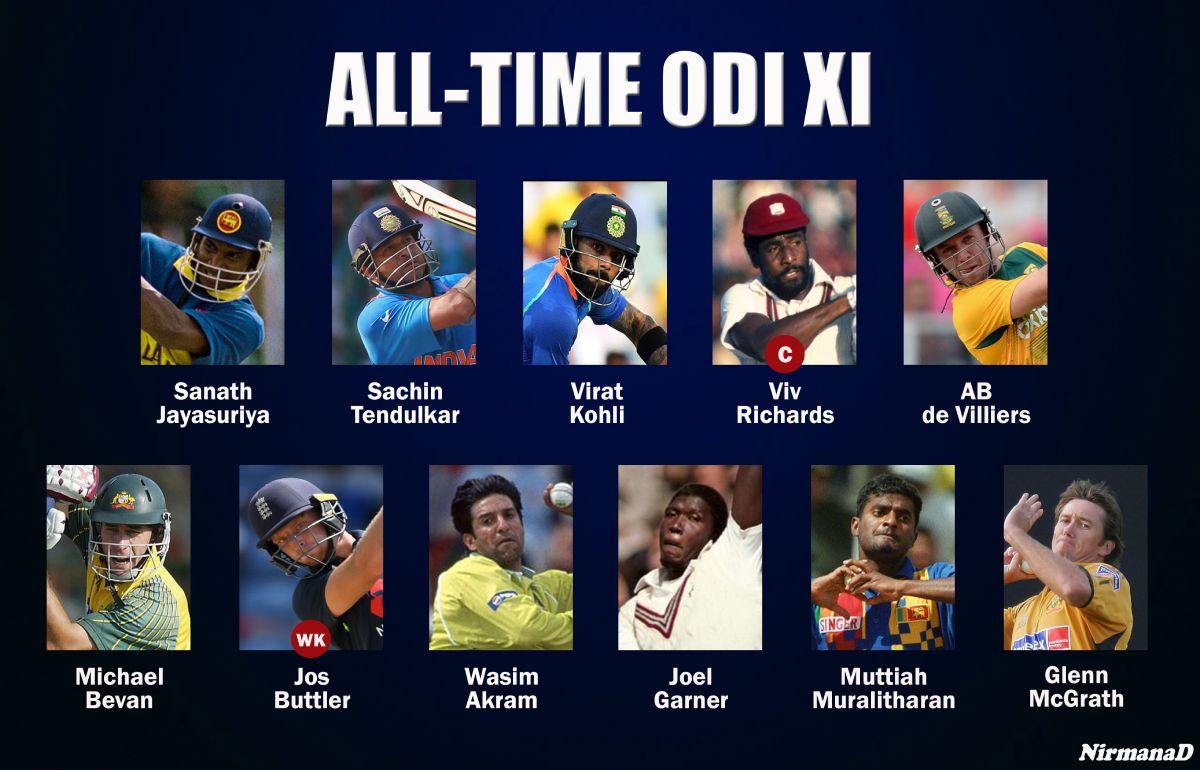Cricket is an analytical game, and so player comparisons to make the game’s all-time XIs, have also become part of it. But how often do we come across comparisons between players of different eras? In such cases, do we give fair consideration to both statistical and non-statistical facts?
Quite often such comparisons are drawn when the statistical records of every player across different eras are shown together. In the meantime, non-statistical factors are overlooked, which underestimates some great players.
Therefore, we need to be mindful not to take those statistics altogether and keep in mind that non-statistical factors also need to be taken into account considering the different eras the players are drawn from.
For such reasons, the inclusion of someone like Sanath Jayasuriya into the all-time ODI XI is a controversial selection to some, when considering purely his numbers.
Let’s see why Sanath Jayasuriya would be the perfect fit into an All-time ODI XI.
Read : Can Sri Lanka win the World Cup in 2023?
1. The role of the player
The ‘Master Blaster’, Jayasuriya is widely regarded as one of the most destructive ODI openers of all time. Apart from being an explosive batter, another important factor we need to keep in mind is that he was a genuine all-rounder who used to play as the 5th bowling option in ODIs. He has 323 wickets in addition to 13,430 runs in ODIs, no mean feat.
Among the batters who have scored over 10,000 runs in ODIs, Sanath Jayasuriya is the only cricketer who also has 300+ wickets to his name.
2. Vacant position for an all-rounder
In cricket, balance is given priority in team selection and an all-rounder is essential to balance the composition of a playing XI. A team can use a 7-4 combination with a genuine all-rounder or a 6-5 combination with a bowling all-rounder, depending on the strengths of the team. At this point we need to keep in mind that it’s tough to balance a team with just a part time bowler.
Also, the 6-5 combination was not really something teams opted for before the introduction of batting-friendly rules in 2011. So between 1971 and 2011, the 5th bowling option was often not a bowling all-rounder but a genuine bowling option.
Let us first look at what I think should be the composition of the all-time ODI XI, to see where an all-rounder would fit.
As mentioned earlier, Jayasuriya’s selection for the all-rounder’s spot may be more controversial than the other 10 players’ selections, as many people measure him solely by statistics.
All of these selections are made based on both statistical criteria and non-statistical factors, taking into account the performance of the era in which they played. (Career record, Impact, consistency, match winning ability, game changing ability, reliability, varieties, longevity, ability to adapt to different conditions and game situations, ability to succeed against many opposition teams, performance in their particular batting position, performance in major tournaments, etc.)
2.1 The batter needed for this composition –
According to the above composition, the all-rounder used in that vacant spot must be,
- A regular opening batsman.
- A genuine all-rounder who can be the 5th bowling option
- An aggressive batter to gain some momentum as the opening partner of someone like Tendulkar.
- If the opener is from a previous era, it will give fair and equal consideration to all 3 eras in ODIs. (I have explained it under point 8.2 in this analysis and that is the main reason for omitting someone like Rohit Sharma)
- If the batter is a left-hander that would be strategically good to make a left-right combination. (not mandatory)
Quite obviously, we cannot find any other player in the history of ODI cricket who is as suitable as Jayasuriya for this vacant position as per the requirements mentioned in all these points. Aside from this, we can also take advantage of having an additional batsman bat at no.7 by including Jayasuriya as an opener considering the team balance.
2.2 The bowler needed for this composition –
Since 3 of the 4 frontline bowlers in this combination are pacemen and one is a spinner, it does not matter whether the 5th bowling option is a paceman or a spinner. That’s because we already have the minimum number of options required for any balanced playing XI from both the pace and spin departments.
However, considering that Muralitharan, the frontline spinner in this combination, is an off-spinner, the inclusion of a genuine leg spin/left arm orthodox option to assist him would inevitably be of great benefit here as it adds variety to the composition.
Even though it is not mandatory, including Sanath Jayasuriya would see to this as well.
Among the other bowling options already in the playing XI, we need to be aware of the fact that Viv Richards is neither a genuine all-rounder nor a leg spinner/left arm orthodox option; he was a part time off spinner. Although Tendulkar and Bevan both bowled spin, both were part-time bowlers.
When it comes back to the genuine all-rounders who bowl spin outside of this playing XI, we cannot find any other all-rounder except Jayasuriya who is at this level.
3. Omitting other all-rounders for various reasons
3.1 Batting position –
In such an argument, we have to be mindful of the difference between each game situation. Because the pressure created for each batting position is completely different. So it depends on how many runs the team has scored and wickets have fallen when the batter comes to the crease.
Therefore, even some of the all-time greats might get omitted as their regular batting position is not vacant in this all-time XI. As a result, even Jacques Kallis, one of the most prolific all-rounders ever produced, can’t find a place here, because he usually bats at no.3 and 4.
3.2 Bowling position –
Traditionally in most all-time XIs, the all-rounder is used to bat in the middle or the lower middle-order (no.6 or 7). But according to the same logic regarding game situations, we cannot pick any of the legendary bowling all-rounders like Kapil Dev, Imran Khan and Shaun Pollock who used to play as regular opening bowlers. So with Akram and McGrath both regular opening bowlers, we cannot include another opening bowler as their role is to bowl more overs using the new ball in the powerplay.
Read More : Sri Lanka needs better systems
But if those all-rounders were the first-change bowlers (ex-Joel Garner’s bowling position as a non-regular opening bowler) to bowl more overs in the middle and death, they would have fit in here.
3.3 Other reasons –
Although bowled as first-change bowlers, the rest of the all-rounders have to be overlooked here as they are slightly behind the above-mentioned legends in terms of greatness. For instance, someone like Lance Klusener did not have a good record anywhere except Africa and Europe. Other notable factors that have led him to be omitted are the fact that he has scored just over 3,576 runs with longevity of only 8 years compared to his other competitors.
Even some of the other all-rounders like Andrew Flintoff, Chris Cairns, and Shahid Afridi who are not in the same league with the aforementioned players have to be omitted here.
4. Batting
Considered one of the finest attacking batters of all-time, Jayasuriya is well known for his powerful striking, match-winning performances, and game-changing ability.
Arguably, he was the most destructive batter in the 1990’s. He made a huge impact in an era before the introduction of batting friendly rules and played T20 caliber batting before T20 cricket was invented.
When it comes to such an analysis, the most important fact that should never be forgotten is that he was the pioneer of revolutionary change in ODI history with his aggressive batting and that impact on the game was to change the way teams approached their batting in the powerplay overs.
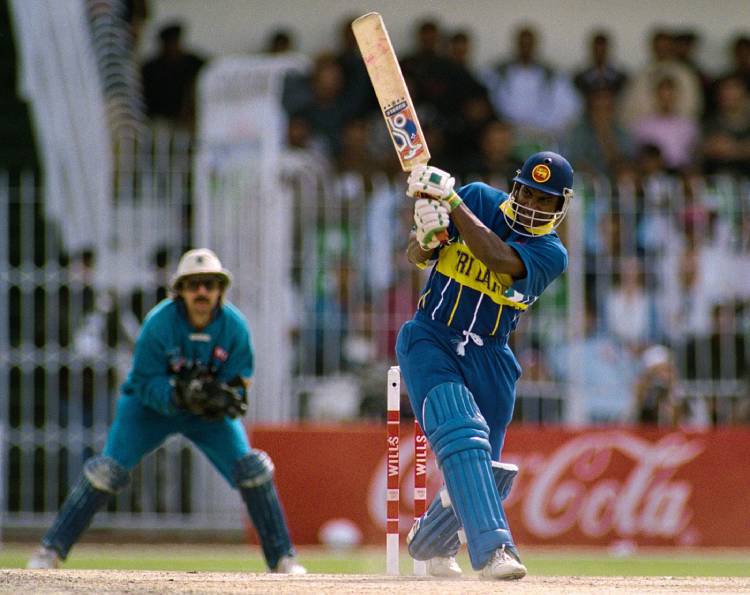
During his illustrious career that spanned over two decades, he scored 12,740 runs at an average of 34.61 as an opener. He is second to only Sachin Tendulkar in the all-time leading run scoring openers’ list in ODIs. (Since this playing XI needs an opener, I will only take into account his performance as an opener considering the situational difference between each batting position.)
At first glance, that average doesn’t look exceptional compared to some of his contemporaries. But the most important thing to keep in mind is that he managed a strike rate of 92.48 in an era when team totals were generally around 230/240. Even if the strike-rate is excluded, such an average is still acceptable for any all-rounder across all 3 eras in ODIs.
When it comes to his performance away from home (away and neutral), he scored 9045 runs at an average of 34.52 and a strike rate of 93.93.
As one of the most astonishing achievements a player can achieve, Jayasuriya stood to be the most valuable player of the 1996 World Cup, ahead of some big names at that time. Although he only managed to score 221 runs through that tournament he was involved in many crucial innings for his team. That award is a perfect example of how much consideration is given to the impact of a player in international cricket.
Throughout his World cup career, he scored 1091 runs at an average of 37.62 and a strike rate of 90.68.
Furthermore, he created many world records during his career. Other than that, the ability to build long innings is also something that needs to be taken into account when it comes to such an argument. So having 28 ODI centuries including four 150+ knocks is exceptional.
Here are some of the greatest knocks he played in his ODI career.
Greatest innings –
- 140(143) against New Zealand in 1994 – https://youtu.be/pOqfS-klIz4
- 79(76) against India, 1996 World Cup – https://youtu.be/uKoc-lmpX6Q
- 82(44) against England, 1996 World Cup quarter final – https://youtu.be/BSVTkZPPIqg
- 134(65) against Pakistan in 1996 – https://youtu.be/2KheU5GAqAs
- 76(28) against Pakistan in 1996 – https://youtu.be/UWVt-q1bMTo
- 151*(120) against India,1997 Independence Cup – https://youtu.be/TLjvPpyGQJc
- 96(67) against Pakistan, 1997 Independence Cup final – https://youtu.be/wxbJk8yplrw
- 189(161) against India, Sharjah trophy 2000 – https://youtu.be/jkseCZwu4pU
- 122(105) against Australia, VB series 2002/03 – https://youtu.be/_HXvZ6ibXvY
- 120(125) against New Zealand, 2003 World Cup – https://youtu.be/anoi1GwtvMk
- 114(96) against Australia, VB series 2006 – https://youtu.be/LBhBmwm1eZg
- 152(99) against England in 2006 – https://youtu.be/ZJs_1PqRck8
- 111(82) against New Zealand in 2006 – https://youtu.be/KspACKyVmy0
- 115(101) against West Indies, 2007 World Cup – https://youtu.be/X2z0Ve74Ou0
- 63(67) against Australia, 2007 World Cup final – https://youtu.be/XFwp_KOzZP8
- 125(114) against India, 2008 Asia Cup final – https://youtu.be/SA5IX8DbpFs
With some valuable knocks scored in vital games, he added “big-match temperament” to his resume and guided his team to clinical victories. He has single-handedly won many matches for his team throughout his splendid career.
In terms of winning impact, the fact that 8,626 of the 12,740 runs (67.70% as a percentage) he scored as an opener was in a winning cause makes him stand out. He scored those 8,626 runs with an average of 42.70 and a strike rate of 96.77. This is the main factor that helps in categorizing a player as a match-winner.
Being one of the most devastated batsmen of all-time, he changed the result of many games while humiliating the bowlers during that time. As a result, he won 48 Man of the Match awards, second only to Tendulkar in ODI history.
5. Bowling
Statistically Jayasuriya has taken 323 wickets at an average of 36.75. I admit that average is not so impressive compared to the other bowlers at that time. But that doesn’t tell half of the story to us. Because Jayasuriya regularly bowled even at death during that time and he was capable of making breakthroughs at crucial points of the game. Considering all that, his economy rate of 4.78 was also a decent number during that time.
Jayasuriya is ahead of other all-rounders as a package that best suits the needs of the composition of the all-time XI even with those seemingly average numbers.
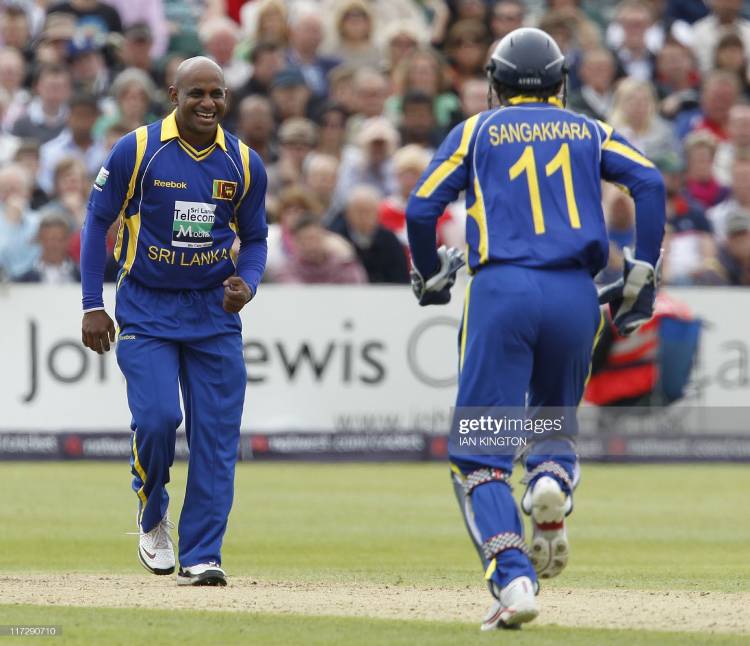
Nevertheless, statistics alone never describe everything directly because we cannot filter how many overs the bowlers bowled in such game situations. On the other hand, the other all-rounders who gave priority to batting didn’t bowl overs at death compared to Jayasuriya.
Here are some of his best bowling performances as mentioned.
Greatest bowling figures –
- 4/53 against South Africa in 1993
- 6/29 against England in 1993 – https://youtu.be/TCCXDOnEGbI
- 5/17 against Pakistan in 2004 – https://youtu.be/_3bb-wgYm-Q
- 5/58 against West Indies in 1997
- 4/49 against Pakistan in 1997
- 4/18 against India in 1998
- 5/28 against Australia in 1999 – https://youtu.be/RXHiTRvtl0g
- 4/39 against Australia in 2003
Other bowling performances in crucial game situations –
- 3/12 against India, 1996 World Cup semi-final including the highest scorer Sachin’s wicket. He broke the most crucial partnership of that game.
- Dismissed both Darren Lehmann and Michael Bevan in one over at the most crucial stage of the 2003 World Cup semi-finals.
- The bowling spell of the 2007 semi-final, including the highest scorer Peter Fulton’s wicket.
- The last over in an ODI in 1997 – https://youtu.be/GJXG85hm9r8 (He defended 9 runs in the last over against Mohammad Azharuddin, conceding only 6 runs.)
- The last over in an ODI in 2006 – https://youtu.be/bSaA80VIRe8 (He bowled 5 dot balls before getting hit for a four off the last ball)
- The last over in an ODI in 2007 – https://youtu.be/N0Mr5WbJEow (He defended 11 runs in the last over against MS Dhoni, conceding only 5 runs.)
Apart from being one of the most trusted bowlers for his team, Jaysuriya has the third-highest number of wickets (323) as a spinner in the ODI history, only behind Muttiah Muralitharan (534) and Shahid Afridi (395).
6. Longevity
Inevitably, we also need to consider the key factor of longevity when it comes to such an argument. Because being able to play a long career while keeping physically and mentally fit with consistent performance over a long period of time is not an easy task for any player.
As a consequence, even some world class players are tempted to retire after playing for around 10-12 years.
So having longevity of more than 21 years in ODIs (21 years and 184 days) is quite simply unparalleled here. During that 21-year long period, Sanath played 445 ODIs, second only to Sachin Tendulkar’s 22-year (22 years and 91 days) longevity.
7. Doesn’t he have any weaknesses?
In terms of negatives, we have to admit that he also had some notable weaknesses when it came to performance in alien conditions. So despite having a phenomenal ODI career, he was not that successful on fast and bouncy tracks from both batting and bowling departments. Other than that he could not succeed in the same way against every opponent.
But in the real world, there is no possibility of finding any player who has no weak points and it depends on the amount of resources produced so far in ODI history.
8. The equal consideration that can be given to some aspects with his inclusion
Let us now see how his inclusion can give equal consideration to many aspects of the composition.
8.1 The fact that selections of the all-time XI are not solely statistics obsessed
Most importantly, we have the possibility of avoiding the accusation that this is another so-called selection based solely on statistics by including such an impact player. Because if we completely exclude non-statistical factors and get too obsessed with statistics, it will inevitably degrade the quality of the selection. So, we must give equal consideration to impact and the other non-statistical factors as well as statistics.
8.2 Avoid giving priority to one particular era
In fact, in the 51 – year history of ODIs, only 11 years so far belong to the modern era considering the introduction of batting-friendly rules by the ICC from October 2011. Therefore, if another batter from the modern era is included as the 4th batter, there will be some injustice to the batters of other eras. That is why we need to make sure that it is not done considering the balance between the eras. So since 3 out of 6 selected batters (Virat Kohli, AB de Villiers, Jos Buttler) on this all-time XI’s batting line mostly played in the modern era, it would not be appropriate to go with another batter as the 4th one from the same era.
(For instance, a paceman like Joel Garner, who has just 146 wickets, is being selected for this all-time XI over the many pacemen who have taken more than double Joel’s number of wickets to give fair consideration to his era. So the same logic applies to Jayasuriya as well.)
In light of all the facts explained above, this is how the all-rounder’s spot in the all-time ODI XI finally fills up.
Now this playing XI has become a well-balanced and strong composition with the inclusion of the underrated genuine all-rounder Sanath Jayasuriya.
From every point explained in detail above, it is obvious that he is a complete package in every aspect. So we have to admit without any hesitation that there is no other player on this planet who fits this genuine all-rounder’s spot on the all-time ODI XI as well as him.
If you have an opinion on Cricket – you get a Free Hit here. Write to [email protected] to be featured!

